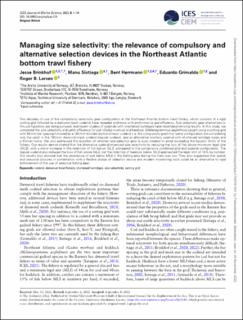| dc.contributor.author | Brinkhof, Jesse | |
| dc.contributor.author | Sistiaga, Manu | |
| dc.contributor.author | Herrmann, Bent | |
| dc.contributor.author | Grimaldo Vela, Eduardo Enrique | |
| dc.contributor.author | Larsen, Roger B. | |
| dc.date.accessioned | 2022-11-18T07:40:29Z | |
| dc.date.available | 2022-11-18T07:40:29Z | |
| dc.date.created | 2022-11-14T15:51:29Z | |
| dc.date.issued | 2022 | |
| dc.identifier.citation | ICES Journal of Marine Science. 2022, . | en_US |
| dc.identifier.issn | 1054-3139 | |
| dc.identifier.uri | https://hdl.handle.net/11250/3032700 | |
| dc.description.abstract | Two decades of use of the compulsory selectivity gear configuration in the Northeast Atlantic bottom trawl fishery, which consists of a rigid sorting grid followed by a diamond mesh codend, have revealed problems with performance and efficiency. Size selectivity gear alternatives to this configuration are being pursued, and recent studies of codends with shortened lastridges have reported promising results. In this study, we compared the size selectivity and catch efficiency for cod (Gadus morhua) and haddock (Melanogrammus aeglefinus) caught using a sorting grid with 55 mm bar spacing followed by a 130 mm knotted diamond mesh codend (i.e. the compulsory gear) that same configuration but considering only the catch in the 130 mm diamond mesh codend (regular codend), and an alternative knotless codend with shortened lastridge ropes and a thinner twine. We also addressed the question of whether size-selective gear is even needed to avoid exceeding the bycatch limits of the fishery. Our results demonstrated that the alternative codend improved size selectivity by reducing the loss of fish above minimum legal size (MLS), with a minor increase in the retention of fish below MLS, compared to the compulsory combined grid and codend configuration. The regular codend also reduced the loss of fish above MLS, but the retention of haddock below MLS approached the legal limit of 15% by number. Our results also showed that the abundance of cod below MLS in the fishing area during the trials was low. They also suggested that spatial and seasonal closures in combination with a flexible choice of selection device and modern monitoring tools could be an alternative to rigid enforcement of the use of selective fishing gear. | en_US |
| dc.language.iso | eng | en_US |
| dc.publisher | Oxford | en_US |
| dc.rights | Navngivelse 4.0 Internasjonal | * |
| dc.rights.uri | http://creativecommons.org/licenses/by/4.0/deed.no | * |
| dc.subject | sorting grid | en_US |
| dc.subject | size selectivity | en_US |
| dc.subject | shortened lastridges | en_US |
| dc.subject | demersal trawl fishery | en_US |
| dc.subject | codend | en_US |
| dc.title | Managing size selectivity: the relevance of compulsory and alternative selection devices in the Northeast Atlantic bottom trawl fishery | en_US |
| dc.title.alternative | Managing size selectivity: the relevance of compulsory and alternative selection devices in the Northeast Atlantic bottom trawl fishery | en_US |
| dc.type | Peer reviewed | en_US |
| dc.type | Journal article | en_US |
| dc.description.version | publishedVersion | en_US |
| dc.rights.holder | Copyright: The Author(s) 2022. | en_US |
| dc.source.pagenumber | 14 | en_US |
| dc.source.journal | ICES Journal of Marine Science | en_US |
| dc.identifier.doi | 10.1093/icesjms/fsac174 | |
| dc.identifier.cristin | 2073739 | |
| dc.relation.project | Fiskeri- og havbruksnæringens forskningsfinansiering: 901633 | en_US |
| cristin.ispublished | true | |
| cristin.fulltext | original | |
| cristin.qualitycode | 2 | |

